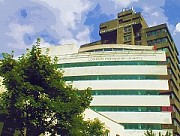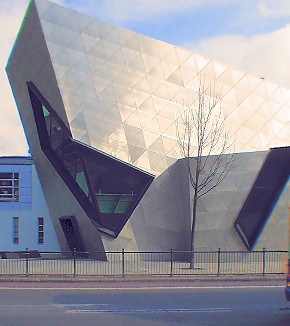|
A major north London thoroughfare (and the capital’s first red route), running north-westward from Highbury Corner to
Archway. The Holloway district takes its name from the road, which was known as the ‘hollow way’ (the road in
a hollow) by the early fourteenth century, when it had become the City’s main route to the north. The hamlet of Ring
Cross had grown up around the junction with Hornsey Road by 1494. By the seventeenth century Holloway Road was notorious for
its highwaymen but it became safer as houses began to connect Ring Cross with Lower Holloway, at the north end of Caledonian
Road. The construction of Archway Road brought an end to the area’s rural character in the 1820s. Holloway Road tube
station opened in 1906, where Ring Cross had been. This section of underground line was constructed in tandem with the overhead
railway running from King’s Cross to Finsbury Park – hence the station’s location, some distance from the more focal Nag’s Head locality. A prototype spiral escalator was installed at the station but never entered service.
Supermarkets have changed the face of Holloway Road over the last few decades. Sainsbury’s demolished a ravishing Victorian
block of shops on their arrival in 1970. A Waitrose supermarket replaced Jones Brothers’ department store in 1993. This
and the opening of a Safeway at Nag’s Head prompted Sainsbury to sell out to Kwiksave (who subsequently retreated in
favour of an Argos superstore). Generally, the road’s mix of retailers is typical of inner (as opposed to central) London
high streets, with the colourful exception of a cluster of fetish fashion shops near the junction with Liverpool Road, including
House of Harlot, Fettered Pleasures, Zeitgeist and the Little Shoe Box. Secondhand shops of all kinds are also in abundance.
 |
 |
|
|
|
 |

|
| The Metropolitan University's graduate school, by leading international architect Daniel Libeskind |
The London Metropolitan University (formerly the University of North London) gained an iconic landmark in 2004 with the opening
of its graduate school, the capital’s first building by the architect Daniel Libeskind; supplementing Rick Mather’s curved white block of 2000 and a brutalist concrete tower from its earlier days as a polytechnic.
Holloway Road was the first home of the Campaign for Nuclear Disarmament on its foundation in 1954,
and of the National Youth Theatre two years later – housed in the former People’s Picture Palace. In the early
1960s record producer Joe Meek created a string of hits at his home-cum-studio at 304 Holloway Road, including the Tornados’
Telstar.
|
 |
|
|
|

